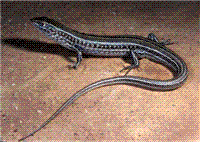Family
Scincidae (Skinks)
Genus
Ctenotus
Species
robustus
Threats/Control Methods - Regional
Threats to the species on a regional level include the modification of previous habitat areas for urban development.
Threats/Control Methods - Local
Within the suburban area, the main threat to the species is disturbance within relatively unmodified habitats such as nature reserves.
Local/Urban Actions
Within the urban area, the main action Canberrans can take for assisting the species is to minimise disturbance (such as collection of wood or interference by pets) to potential habitats.
Common name/s
Striped Skink, Robust Ctenotus
Distinguishing Features
The Striped Skink is mostly brown above, with a black stripe with white edges running down the centre of the back and tail. A black and a white line run side by side down the upper flanks, while the skink's sides are dark, speckled with paler brown. The sides become lighter towards the underside of the lizard. The Striped Skink is relatively large, growing to a maximum length of around 30cm, including the tail which may make up 2/3 of its length.
Similar Species
The species most closely resembling the Striped Skink is the Spotted-back Skink (Ctenotus uber orientalis ), however, the Striped Skink has a solid stripe running either side of its back, while the Spotted-back Skink has a row of dots.
Distribution
The Striped Skink occupies extensive areas of eastern and northern Australia. Its range extends from northern parts of Western Australia and the Northern Territory, through eastern Queensland and into New South Wales, Victoria and eastern South Australia. In the ACT, the Striped Skink occupies warmer areas to the north and east of the territory.
Country of Origin
Australia
Survey Techniques
Pitfall trapping and hand searching are used in surveys for this species.
Conservation (Pet/Pest) Status - National
Not listed as a threatened species under the EPBC Act 1999.
Conservation (Pet/Pest) Status - Regional
The Striped Skink is quite common in the region, although not often seen.
LSCCES Population
Not common in urban areas, although relatively undisturbed parts of nature reserve may provide suitable habitat for the species.
Associated vegetation community
Forest, woodland, shrubland and heath.
Limiting Resources
The species prefers relatively undisturbed habitats or areas of low grazing pressure. Human activities will tend to deter the lizards from otherwise appropriate habitat areas.
Breeding
The female Striped Skink lays an average of six eggs, with larger skinks usually laying more eggs. Eggs are laid in late winter or spring and these hatch about 2 months later.
Behaviour
The Striped Skink is surface active, using rocks, logs and ground litter for shelter. It creates burrows under rocks, which is uses for hibernation and nesting. It is diurnal.
Functional Group
Insectivore
Food Species
The Striped skink feeds mostly on arthropods, although young lizards are sometimes eaten.
Predators
The species has been recorded as being preyed upon by snakes and feral cats.
Interesting Fact
The Striped Skink is very shy, and it will disappear quickly into a hole or underneath shelter when humans approach. As such, it is uncommon to see the skinks.
References - (reader suitability of references, P=Primary teachers, S=Secondary students, T=Tertiary students and researchers)
Books:
Bennett, R. 1997. Reptiles & Frogs of the Australian Capital Territory, National Parks Association of the ACT, Woden. S, T
Cogger, H.G. 1996. Reptiles and Amphibians of Australia, Reed Books Australia, Melbourne. S, T
Swan, G., Shea, G. and Sadlier, R. 2004. A Field Guide to Reptiles of New South Wales, Second Edition, Reed New Holland, Sydney. S, T
Researcher: Ian Rayner

 Top
Top Top
Top